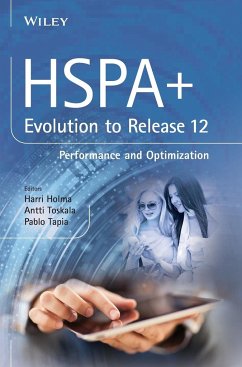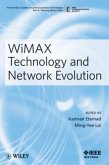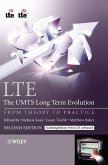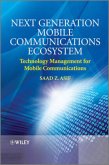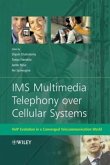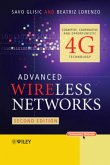HSPA+ Evolution to Release 12
Performance and Optimization
Herausgegeben von Holma, Harri; Toskala, Antti; Tapia, Pablo
HSPA+ Evolution to Release 12
Performance and Optimization
Herausgegeben von Holma, Harri; Toskala, Antti; Tapia, Pablo
- Gebundenes Buch
- Merkliste
- Auf die Merkliste
- Bewerten Bewerten
- Teilen
- Produkt teilen
- Produkterinnerung
- Produkterinnerung
A comprehensive reference book codifying the various standards releases for High Speed Packet Access (HSPA) wireless technology
HSPA evolution has maintained its prominence through Releases 7-11 but the evolution is coming to an end with Release 12, with the focus moving to LTE. However, HSPA network and terminal sales will continue for many years: HSPA is expected to remain as the number one radio access technology from the sales point of view far beyond 2015. This timely book examines the complete HSPA evolution, and will be the ultimate long term reference for HSPA evolution.
Headed…mehr
Andere Kunden interessierten sich auch für
![Hspa Performance and Evolution Hspa Performance and Evolution]() Pablo TapiaHspa Performance and Evolution130,99 €
Pablo TapiaHspa Performance and Evolution130,99 €![Lte and the Evolution to 4g Wireless Lte and the Evolution to 4g Wireless]() Agilent TechnologiesLte and the Evolution to 4g Wireless132,99 €
Agilent TechnologiesLte and the Evolution to 4g Wireless132,99 €![WiMAX Technology and Network Evolution WiMAX Technology and Network Evolution]() Kamran EtemadWiMAX Technology and Network Evolution79,99 €
Kamran EtemadWiMAX Technology and Network Evolution79,99 €![Lte - The Umts Long Term Evolution Lte - The Umts Long Term Evolution]() Stefania SesiaLte - The Umts Long Term Evolution134,99 €
Stefania SesiaLte - The Umts Long Term Evolution134,99 €![Next Generation Mobile Communications Ecosystem Next Generation Mobile Communications Ecosystem]() Saad Z. AsifNext Generation Mobile Communications Ecosystem130,99 €
Saad Z. AsifNext Generation Mobile Communications Ecosystem130,99 €![IMS Multimedia Telephony Over Cellular Systems IMS Multimedia Telephony Over Cellular Systems]() Shyam ChakrabortyIMS Multimedia Telephony Over Cellular Systems139,99 €
Shyam ChakrabortyIMS Multimedia Telephony Over Cellular Systems139,99 €![Advanced Wireless Networks Advanced Wireless Networks]() Savo GlisicAdvanced Wireless Networks174,99 €
Savo GlisicAdvanced Wireless Networks174,99 €-
-
-
A comprehensive reference book codifying the various standards releases for High Speed Packet Access (HSPA) wireless technology
HSPA evolution has maintained its prominence through Releases 7-11 but the evolution is coming to an end with Release 12, with the focus moving to LTE. However, HSPA network and terminal sales will continue for many years: HSPA is expected to remain as the number one radio access technology from the sales point of view far beyond 2015. This timely book examines the complete HSPA evolution, and will be the ultimate long term reference for HSPA evolution.
Headed by the successful editing team of Holma, Toskala and Tapia, industry experts look at HSPA evolution including complete Release 11 and the main additions in Release 12. They describe 3GPP definitions, field measurement, expected performance, practical optimization guidelines and the implications to the devices and to the networks. The book also covers MIMO antenna solutions and multicarrier evolution to provide higher data rates. Dedicated chapters include Continuous Packet Connectivity and High Speed Common Channels which provide major improvement to the smartphone capacity, end user performance and power consumption. The book assumes basic understanding of mobile communications yet the material is presented in an understandable way which can be enjoyed without any pre-information about MIMO or other technology solutions.
A comprehensive reference book codifying the various standards releases for High Speed Packet Access (HSPA) wireless technology
Leading editor and contributor team focusing their expertise on 3GPP features and performance, including Self Organizing Networks, LTE Interworking, Smartphone Optimization and Voice Evolution
Dedicated chapter covering VoIP over HSPA, recognizing that telephony will continue to bring most of the revenues to mobile operators in the near future
Includes tables, figures and plots illustrating the concepts or simulation results, to aid readers' understanding of the topic
An essential resource for R&D engineers by network, terminal and chip set vendors, network engineers with operators, application developers, regulators.
Hinweis: Dieser Artikel kann nur an eine deutsche Lieferadresse ausgeliefert werden.
HSPA evolution has maintained its prominence through Releases 7-11 but the evolution is coming to an end with Release 12, with the focus moving to LTE. However, HSPA network and terminal sales will continue for many years: HSPA is expected to remain as the number one radio access technology from the sales point of view far beyond 2015. This timely book examines the complete HSPA evolution, and will be the ultimate long term reference for HSPA evolution.
Headed by the successful editing team of Holma, Toskala and Tapia, industry experts look at HSPA evolution including complete Release 11 and the main additions in Release 12. They describe 3GPP definitions, field measurement, expected performance, practical optimization guidelines and the implications to the devices and to the networks. The book also covers MIMO antenna solutions and multicarrier evolution to provide higher data rates. Dedicated chapters include Continuous Packet Connectivity and High Speed Common Channels which provide major improvement to the smartphone capacity, end user performance and power consumption. The book assumes basic understanding of mobile communications yet the material is presented in an understandable way which can be enjoyed without any pre-information about MIMO or other technology solutions.
A comprehensive reference book codifying the various standards releases for High Speed Packet Access (HSPA) wireless technology
Leading editor and contributor team focusing their expertise on 3GPP features and performance, including Self Organizing Networks, LTE Interworking, Smartphone Optimization and Voice Evolution
Dedicated chapter covering VoIP over HSPA, recognizing that telephony will continue to bring most of the revenues to mobile operators in the near future
Includes tables, figures and plots illustrating the concepts or simulation results, to aid readers' understanding of the topic
An essential resource for R&D engineers by network, terminal and chip set vendors, network engineers with operators, application developers, regulators.
Hinweis: Dieser Artikel kann nur an eine deutsche Lieferadresse ausgeliefert werden.
Produktdetails
- Produktdetails
- Verlag: Wiley & Sons
- Artikelnr. des Verlages: 1W118503210
- 1. Auflage
- Seitenzahl: 464
- Erscheinungstermin: 22. September 2014
- Englisch
- Abmessung: 250mm x 175mm x 29mm
- Gewicht: 976g
- ISBN-13: 9781118503218
- ISBN-10: 111850321X
- Artikelnr.: 40784294
- Herstellerkennzeichnung
- Libri GmbH
- Europaallee 1
- 36244 Bad Hersfeld
- gpsr@libri.de
- Verlag: Wiley & Sons
- Artikelnr. des Verlages: 1W118503210
- 1. Auflage
- Seitenzahl: 464
- Erscheinungstermin: 22. September 2014
- Englisch
- Abmessung: 250mm x 175mm x 29mm
- Gewicht: 976g
- ISBN-13: 9781118503218
- ISBN-10: 111850321X
- Artikelnr.: 40784294
- Herstellerkennzeichnung
- Libri GmbH
- Europaallee 1
- 36244 Bad Hersfeld
- gpsr@libri.de
Editors: Harri Holma, Antti Toskala, Nokia Siemens Networks, Finland and Pablo Tapia, T-Mobile, USA
Foreword xv
Preface xvii
Abbreviations xix
1 Introduction 1
Harri Holma
1.1 Introduction 1
1.2 HSPA Global Deployments 1
1.3 Mobile Devices 3
1.4 Traffic Growth 3
1.5 HSPA Technology Evolution 5
1.6 HSPA Optimization Areas 7
1.7 Summary 7
2 HSDPA and HSUPA in Release 5 and 6 9
Antti Toskala
2.1 Introduction 9
2.2 3GPP Standardization of HSDPA and HSUPA 9
2.3 HSDPA Technology Key Characteristics 10
2.4 HSDPA Mobility 16
2.5 HSDPA UE Capability 17
2.6 HSUPA Technology Key Characteristics 17
2.7 HSUPA Mobility 22
2.8 HSUPA UE Capability 23
2.9 HSPA Architecture Evolution 23
2.10 Conclusions 24
References 24
3 Multicarrier and Multiantenna MIMO 27
Antti Toskala, Jeroen Wigard, Matthias Hesse, Ryszard Dokuczal, and Maciej
Januszewski
3.1 Introduction 27
3.2 Dual-Cell Downlink and Uplink 27
3.2.1 Dual-Cell Downlink 28
3.2.2 Dual-Cell HSUPA 32
3.3 Four-Carrier HSDPA and Beyond 33
3.4 Multiband HSDPA 36
3.5 Downlink MIMO 38
3.5.1 Space Time Transmit Diversity - STTD 39
3.5.2 Closed-Loop Mode 1 Transmit Diversity 39
3.5.3 2 × 2 MIMO and TxAA 40
3.5.4 4-Branch MIMO 42
3.6 Uplink MIMO and Uplink Closed-Loop Transmit Diversity 46
3.6.1 Uplink MIMO Channel Architecture 47
3.6.2 Scheduling and Rank Selection with Uplink MIMO 49
3.6.3 Uplink MIMO Performance Evaluation 50
3.7 Conclusions 52
References 52
4 Continuous Packet Connectivity and High Speed Common Channels 53
Harri Holma and Karri Ranta-aho
4.1 Introduction 53
4.2 Continuous Packet Connectivity (CPC) 54
4.2.1 Uplink DTX 55
4.2.2 Downlink DRX 58
4.2.3 HS-SCCH-Less Transmission 59
4.3 High Speed FACH 61
4.4 High Speed RACH 63
4.5 High Speed FACH and RACH Enhancements 66
4.6 Fast Dormancy 67
4.7 Uplink Interference Reduction 68
4.8 Terminal Power Consumption Minimization 72
4.9 Signaling Reduction 73
4.10 Latency Optimization 74
4.11 Summary 75
References 75
5 HSDPA Multiflow 77
Thomas Höhne, Karri Ranta-aho, Alexander Sayenko, and Antti Toskala
5.1 Introduction 77
5.2 Multiflow Overview 77
5.2.1 Multiflow Principle 78
5.2.2 Multiflow Configurations 78
5.3 Multiflow Protocol Stack 80
5.4 Multiflow Impacts on UE Architecture 80
5.5 Uplink Feedback for Multiflow 81
5.5.1 HS-DPCCH Structure with Multiflow 81
5.5.2 Dynamic Carrier Activation 84
5.5.3 Timing of Uplink Feedback 84
5.5.4 HS-DPCCH Power Levels 86
5.6 RLC Impact 87
5.6.1 RLC Timer_Reordering 87
5.6.2 RLC Reset 88
5.7 Iub/Iur Enhancements 89
5.7.1 Flow Control 89
5.7.2 Multiflow Extensions 90
5.8 Multiflow Combined with Other Features 91
5.8.1 Downlink MIMO 91
5.8.2 Uplink Closed-Loop Transmit Diversity and Uplink MIMO 91
5.8.3 DTX/DRX 92
5.9 Setting Up Multiflow 93
5.10 Robustness 94
5.10.1 Robustness for RRC Signaling 94
5.10.2 Radio Link Failure 94
5.10.3 Robustness for User Plane Data 96
5.11 Multiflow Performance 96
5.11.1 Multiflow Performance in Macro Networks 96
5.11.2 Multiflow Performance with HetNets 96
5.12 Multiflow and Other Multipoint Transmission Techniques 100
5.13 Conclusions 100
References 100
6 Voice Evolution 103
Harri Holma and Karri Ranta-aho
6.1 Introduction 103
6.2 Voice Quality with AMR Wideband 103
6.3 Voice Capacity with Low Rate AMR 106
6.4 VoIP Over HSPA 107
6.5 Circuit-Switched Voice Over HSPA 111
6.6 Voice Over HSPA Mobility 112
6.7 Circuit-Switched Fallback 114
6.8 Single Radio Voice Call Continuity 115
6.9 Summary 116
References 116
7 Heterogeneous Networks 117
Harri Holma and Fernando Sanchez Moya
7.1 Introduction 117
7.2 Small Cell Drivers 117
7.3 Base Station Categories 118
7.4 Small Cell Dominance Areas 119
7.5 HetNet Uplink-Downlink Imbalance 122
7.6 HetNet Capacity and Data Rates 124
7.7 HetNet Field Measurements 128
7.8 Femto Cells 130
7.9 WLAN Interworking 133
7.9.1 Access Network Discovery and Selection Function (ANDSF) 133
7.9.2 Hotspot 2.0 135
7.9.3 Differences between ANDSF and Hotspot 2.0 136
7.10 Summary 136
References 137
8 Advanced UE and BTS Algorithms 139
Antti Toskala and Hisashi Onozawa
8.1 Introduction 139
8.2 Advanced UE Receivers 139
8.3 BTS Scheduling Alternatives 143
8.4 BTS Interference Cancellation 145
8.5 Further Advanced UE and BTS Algorithms 149
8.6 Conclusions 150
References 151
9 IMT-Advanced Performance Evaluation 153
Karri Ranta-aho and Antti Toskala
9.1 Introduction 153
9.2 ITU-R Requirements for IMT-Advanced 153
9.3 3GPP Features to Consider in Meeting the IMT-Advanced Requirements 155
9.4 Performance Evaluation 157
9.4.1 Eight-Carrier HSDPA 157
9.4.2 Four-Antenna MIMO for HSDPA 159
9.4.3 Uplink Beamforming, MIMO and 64QAM 160
9.4.4 HSPA+ Multiflow 162
9.4.5 Performance in Different ITU-R Scenarios 163
9.4.6 Latency and Handover Interruption Analysis 164
9.5 Conclusions 168
References 168
10 HSPA+ Performance 169
Pablo Tapia and Brian Olsen
10.1 Introduction 169
10.2 Test Tools and Methodology 170
10.3 Single-Carrier HSPA+ 173
10.3.1 Test Scenarios 173
10.3.2 Latency Measurements 174
10.3.3 Good Signal Strength Scenario 175
10.3.4 Mid Signal Strength Scenario 177
10.3.5 Poor Signal Strength Scenario 179
10.3.6 Summary of Stationary Tests 182
10.3.7 Drive Test Performance of Single-Carrier HSPA+ 183
10.4 Dual-Cell HSPA+ 188
10.4.1 Stationary Performance 189
10.4.2 Dual-Carrier Drive Performance 192
10.4.3 Impact of Vendor Implementation 196
10.5 Analysis of Other HSPA Features 198
10.5.1 64 QAM Gains 198
10.5.2 UE Advanced Receiver Field Results 200
10.5.3 2 × 2 MIMO 203
10.5.4 Quality of Service (QoS) 206
10.6 Comparison of HSPA+ with LTE 209
10.7 Summary 211
References 212
11 Network Planning 213
Brian Olsen, Pablo Tapia, Jussi Reunanen, and Harri Holma
11.1 Introduction 213
11.2 Radio Frequency Planning 213
11.2.1 Link Budget 215
11.2.2 Antenna and Power Planning 219
11.2.3 Automatic Cell Planning (ACP) Tools 222
11.2.4 Neighbor Planning 223
11.3 Multilayer Management in HSPA 224
11.3.1 Layering Strategy within Single Band 225
11.3.2 Layering Strategy with Multiple UMTS Bands 230
11.3.3 Summary 233
11.4 RAN Capacity Planning 233
11.4.1 Discussion on Capacity Triggers 234
11.4.2 Effect of Voice/Data Load 237
11.4.3 Uplink Noise Discussion 238
11.4.4 Sector Dimensioning 240
11.4.5 RNC Dimensioning 242
11.5 Packet Core and Transport Planning 243
11.5.1 Backhaul Dimensioning 244
11.6 Spectrum Refarming 246
11.6.1 Introduction 246
11.6.2 UMTS Spectrum Requirements 247
11.6.3 GSM Features for Refarming 249
11.6.4 Antenna Sharing Solutions 249
11.7 Summary 250
References 251
12 Radio Network Optimization 253
Pablo Tapia and Carl Williams
12.1 Introduction 253
12.2 Optimization of the Radio Access Network Parameters 254
12.2.1 Optimization of Antenna Parameters 255
12.2.2 Optimization of Power Parameters 257
12.2.3 Neighbor List Optimization 262
12.2.4 HS Cell Change Optimization 265
12.2.5 IRAT Handover Optimization 268
12.2.6 Optimization of Radio State Transitions 271
12.2.7 Uplink Noise Optimization 275
12.3 Optimization Tools 281
12.3.1 Geolocation 284
12.3.2 User Tracing (Minimization of Drive Tests) 285
12.3.3 Self Organizing Network (SON) Tools 286
12.4 Summary 292
Reference 292
13 Smartphone Performance 293
Pablo Tapia, Michael Thelander, Timo Halonen, Jeff Smith, and Mika Aalto
13.1 Introduction 293
13.2 Smartphone Traffic Analysis 294
13.3 Smartphone Data Consumption 297
13.4 Smartphone Signaling Analysis 299
13.4.1 Smartphone Profiling 301
13.4.2 Ranking Based on Key Performance Indicators 302
13.4.3 Test Methodology 303
13.4.4 KPIs Analyzed during Profiling 304
13.4.5 Use Case Example: Analysis of Signaling by Various Mobile OSs 306
13.5 Smartphone Performance 308
13.5.1 User Experience KPIs 310
13.5.2 Battery Performance 311
13.5.3 Coverage Limits for Different Services 313
13.5.4 Effect of TCP Performance 315
13.5.5 Web Browsing Performance 318
13.5.6 Video Streaming 321
13.6 Use Case Study: Analysis of Smartphone User Experience in the US 330
13.7 Summary 334
References 335
14 Multimode Multiband Terminal Design Challenges 337
Jean-Marc Lemenager, Luigi Di Capua, Victor Wilkerson, Mikaël Guenais,
Thierry Meslet, and Laurent Noël
14.1 Cost Reduction in Multimode Multiband Terminals 340
14.1.1 Evolution of Silicon Area and Component Count 340
14.1.2 Transceiver Architecture Evolutions 342
14.1.3 RF Front End 350
14.2 Power Consumption Reduction in Terminals 369
14.2.1 Smartphone Power Consumption 369
14.2.2 Application Engines 371
14.2.3 Power Amplifiers 378
14.2.4 Continuous Packet Connectivity 382
14.3 Conclusion 387
References 389
15 LTE Interworking 393
Harri Holma and Hannu Raassina
15.1 Introduction 393
15.2 Packet Data Interworking 394
15.2.1 Example Trace of 3G to LTE Cell Reselection 398
15.2.2 Example Trace of LTE to 3G Redirection 400
15.3 Circuit-Switched Fallback 406
15.3.1 Example Circuit-Switched Fallback with Location Area Update 410
15.3.2 Example Circuit-Switched Fallback without Location Area Update 413
15.4 Matching of LTE and 3G Coverage Areas 415
15.5 Single Radio Voice Call Continuity (SRVCC) 417
15.6 Summary 419
References 419
16 HSPA Evolution Outlook 421
Antti Toskala and Karri Ranta-aho
16.1 Introduction 421
16.2 HSPA-LTE and WLAN Interworking 421
16.3 Scalable Bandwidth UMTS 423
16.4 DCH Enhancements 425
16.5 HSUPA Enhancements 427
16.6 Heterogenous Networks 428
16.7 Other Areas of Improvement for Release 12 and Beyond 430
16.8 Conclusions 430
References 431
Index 433
Preface xvii
Abbreviations xix
1 Introduction 1
Harri Holma
1.1 Introduction 1
1.2 HSPA Global Deployments 1
1.3 Mobile Devices 3
1.4 Traffic Growth 3
1.5 HSPA Technology Evolution 5
1.6 HSPA Optimization Areas 7
1.7 Summary 7
2 HSDPA and HSUPA in Release 5 and 6 9
Antti Toskala
2.1 Introduction 9
2.2 3GPP Standardization of HSDPA and HSUPA 9
2.3 HSDPA Technology Key Characteristics 10
2.4 HSDPA Mobility 16
2.5 HSDPA UE Capability 17
2.6 HSUPA Technology Key Characteristics 17
2.7 HSUPA Mobility 22
2.8 HSUPA UE Capability 23
2.9 HSPA Architecture Evolution 23
2.10 Conclusions 24
References 24
3 Multicarrier and Multiantenna MIMO 27
Antti Toskala, Jeroen Wigard, Matthias Hesse, Ryszard Dokuczal, and Maciej
Januszewski
3.1 Introduction 27
3.2 Dual-Cell Downlink and Uplink 27
3.2.1 Dual-Cell Downlink 28
3.2.2 Dual-Cell HSUPA 32
3.3 Four-Carrier HSDPA and Beyond 33
3.4 Multiband HSDPA 36
3.5 Downlink MIMO 38
3.5.1 Space Time Transmit Diversity - STTD 39
3.5.2 Closed-Loop Mode 1 Transmit Diversity 39
3.5.3 2 × 2 MIMO and TxAA 40
3.5.4 4-Branch MIMO 42
3.6 Uplink MIMO and Uplink Closed-Loop Transmit Diversity 46
3.6.1 Uplink MIMO Channel Architecture 47
3.6.2 Scheduling and Rank Selection with Uplink MIMO 49
3.6.3 Uplink MIMO Performance Evaluation 50
3.7 Conclusions 52
References 52
4 Continuous Packet Connectivity and High Speed Common Channels 53
Harri Holma and Karri Ranta-aho
4.1 Introduction 53
4.2 Continuous Packet Connectivity (CPC) 54
4.2.1 Uplink DTX 55
4.2.2 Downlink DRX 58
4.2.3 HS-SCCH-Less Transmission 59
4.3 High Speed FACH 61
4.4 High Speed RACH 63
4.5 High Speed FACH and RACH Enhancements 66
4.6 Fast Dormancy 67
4.7 Uplink Interference Reduction 68
4.8 Terminal Power Consumption Minimization 72
4.9 Signaling Reduction 73
4.10 Latency Optimization 74
4.11 Summary 75
References 75
5 HSDPA Multiflow 77
Thomas Höhne, Karri Ranta-aho, Alexander Sayenko, and Antti Toskala
5.1 Introduction 77
5.2 Multiflow Overview 77
5.2.1 Multiflow Principle 78
5.2.2 Multiflow Configurations 78
5.3 Multiflow Protocol Stack 80
5.4 Multiflow Impacts on UE Architecture 80
5.5 Uplink Feedback for Multiflow 81
5.5.1 HS-DPCCH Structure with Multiflow 81
5.5.2 Dynamic Carrier Activation 84
5.5.3 Timing of Uplink Feedback 84
5.5.4 HS-DPCCH Power Levels 86
5.6 RLC Impact 87
5.6.1 RLC Timer_Reordering 87
5.6.2 RLC Reset 88
5.7 Iub/Iur Enhancements 89
5.7.1 Flow Control 89
5.7.2 Multiflow Extensions 90
5.8 Multiflow Combined with Other Features 91
5.8.1 Downlink MIMO 91
5.8.2 Uplink Closed-Loop Transmit Diversity and Uplink MIMO 91
5.8.3 DTX/DRX 92
5.9 Setting Up Multiflow 93
5.10 Robustness 94
5.10.1 Robustness for RRC Signaling 94
5.10.2 Radio Link Failure 94
5.10.3 Robustness for User Plane Data 96
5.11 Multiflow Performance 96
5.11.1 Multiflow Performance in Macro Networks 96
5.11.2 Multiflow Performance with HetNets 96
5.12 Multiflow and Other Multipoint Transmission Techniques 100
5.13 Conclusions 100
References 100
6 Voice Evolution 103
Harri Holma and Karri Ranta-aho
6.1 Introduction 103
6.2 Voice Quality with AMR Wideband 103
6.3 Voice Capacity with Low Rate AMR 106
6.4 VoIP Over HSPA 107
6.5 Circuit-Switched Voice Over HSPA 111
6.6 Voice Over HSPA Mobility 112
6.7 Circuit-Switched Fallback 114
6.8 Single Radio Voice Call Continuity 115
6.9 Summary 116
References 116
7 Heterogeneous Networks 117
Harri Holma and Fernando Sanchez Moya
7.1 Introduction 117
7.2 Small Cell Drivers 117
7.3 Base Station Categories 118
7.4 Small Cell Dominance Areas 119
7.5 HetNet Uplink-Downlink Imbalance 122
7.6 HetNet Capacity and Data Rates 124
7.7 HetNet Field Measurements 128
7.8 Femto Cells 130
7.9 WLAN Interworking 133
7.9.1 Access Network Discovery and Selection Function (ANDSF) 133
7.9.2 Hotspot 2.0 135
7.9.3 Differences between ANDSF and Hotspot 2.0 136
7.10 Summary 136
References 137
8 Advanced UE and BTS Algorithms 139
Antti Toskala and Hisashi Onozawa
8.1 Introduction 139
8.2 Advanced UE Receivers 139
8.3 BTS Scheduling Alternatives 143
8.4 BTS Interference Cancellation 145
8.5 Further Advanced UE and BTS Algorithms 149
8.6 Conclusions 150
References 151
9 IMT-Advanced Performance Evaluation 153
Karri Ranta-aho and Antti Toskala
9.1 Introduction 153
9.2 ITU-R Requirements for IMT-Advanced 153
9.3 3GPP Features to Consider in Meeting the IMT-Advanced Requirements 155
9.4 Performance Evaluation 157
9.4.1 Eight-Carrier HSDPA 157
9.4.2 Four-Antenna MIMO for HSDPA 159
9.4.3 Uplink Beamforming, MIMO and 64QAM 160
9.4.4 HSPA+ Multiflow 162
9.4.5 Performance in Different ITU-R Scenarios 163
9.4.6 Latency and Handover Interruption Analysis 164
9.5 Conclusions 168
References 168
10 HSPA+ Performance 169
Pablo Tapia and Brian Olsen
10.1 Introduction 169
10.2 Test Tools and Methodology 170
10.3 Single-Carrier HSPA+ 173
10.3.1 Test Scenarios 173
10.3.2 Latency Measurements 174
10.3.3 Good Signal Strength Scenario 175
10.3.4 Mid Signal Strength Scenario 177
10.3.5 Poor Signal Strength Scenario 179
10.3.6 Summary of Stationary Tests 182
10.3.7 Drive Test Performance of Single-Carrier HSPA+ 183
10.4 Dual-Cell HSPA+ 188
10.4.1 Stationary Performance 189
10.4.2 Dual-Carrier Drive Performance 192
10.4.3 Impact of Vendor Implementation 196
10.5 Analysis of Other HSPA Features 198
10.5.1 64 QAM Gains 198
10.5.2 UE Advanced Receiver Field Results 200
10.5.3 2 × 2 MIMO 203
10.5.4 Quality of Service (QoS) 206
10.6 Comparison of HSPA+ with LTE 209
10.7 Summary 211
References 212
11 Network Planning 213
Brian Olsen, Pablo Tapia, Jussi Reunanen, and Harri Holma
11.1 Introduction 213
11.2 Radio Frequency Planning 213
11.2.1 Link Budget 215
11.2.2 Antenna and Power Planning 219
11.2.3 Automatic Cell Planning (ACP) Tools 222
11.2.4 Neighbor Planning 223
11.3 Multilayer Management in HSPA 224
11.3.1 Layering Strategy within Single Band 225
11.3.2 Layering Strategy with Multiple UMTS Bands 230
11.3.3 Summary 233
11.4 RAN Capacity Planning 233
11.4.1 Discussion on Capacity Triggers 234
11.4.2 Effect of Voice/Data Load 237
11.4.3 Uplink Noise Discussion 238
11.4.4 Sector Dimensioning 240
11.4.5 RNC Dimensioning 242
11.5 Packet Core and Transport Planning 243
11.5.1 Backhaul Dimensioning 244
11.6 Spectrum Refarming 246
11.6.1 Introduction 246
11.6.2 UMTS Spectrum Requirements 247
11.6.3 GSM Features for Refarming 249
11.6.4 Antenna Sharing Solutions 249
11.7 Summary 250
References 251
12 Radio Network Optimization 253
Pablo Tapia and Carl Williams
12.1 Introduction 253
12.2 Optimization of the Radio Access Network Parameters 254
12.2.1 Optimization of Antenna Parameters 255
12.2.2 Optimization of Power Parameters 257
12.2.3 Neighbor List Optimization 262
12.2.4 HS Cell Change Optimization 265
12.2.5 IRAT Handover Optimization 268
12.2.6 Optimization of Radio State Transitions 271
12.2.7 Uplink Noise Optimization 275
12.3 Optimization Tools 281
12.3.1 Geolocation 284
12.3.2 User Tracing (Minimization of Drive Tests) 285
12.3.3 Self Organizing Network (SON) Tools 286
12.4 Summary 292
Reference 292
13 Smartphone Performance 293
Pablo Tapia, Michael Thelander, Timo Halonen, Jeff Smith, and Mika Aalto
13.1 Introduction 293
13.2 Smartphone Traffic Analysis 294
13.3 Smartphone Data Consumption 297
13.4 Smartphone Signaling Analysis 299
13.4.1 Smartphone Profiling 301
13.4.2 Ranking Based on Key Performance Indicators 302
13.4.3 Test Methodology 303
13.4.4 KPIs Analyzed during Profiling 304
13.4.5 Use Case Example: Analysis of Signaling by Various Mobile OSs 306
13.5 Smartphone Performance 308
13.5.1 User Experience KPIs 310
13.5.2 Battery Performance 311
13.5.3 Coverage Limits for Different Services 313
13.5.4 Effect of TCP Performance 315
13.5.5 Web Browsing Performance 318
13.5.6 Video Streaming 321
13.6 Use Case Study: Analysis of Smartphone User Experience in the US 330
13.7 Summary 334
References 335
14 Multimode Multiband Terminal Design Challenges 337
Jean-Marc Lemenager, Luigi Di Capua, Victor Wilkerson, Mikaël Guenais,
Thierry Meslet, and Laurent Noël
14.1 Cost Reduction in Multimode Multiband Terminals 340
14.1.1 Evolution of Silicon Area and Component Count 340
14.1.2 Transceiver Architecture Evolutions 342
14.1.3 RF Front End 350
14.2 Power Consumption Reduction in Terminals 369
14.2.1 Smartphone Power Consumption 369
14.2.2 Application Engines 371
14.2.3 Power Amplifiers 378
14.2.4 Continuous Packet Connectivity 382
14.3 Conclusion 387
References 389
15 LTE Interworking 393
Harri Holma and Hannu Raassina
15.1 Introduction 393
15.2 Packet Data Interworking 394
15.2.1 Example Trace of 3G to LTE Cell Reselection 398
15.2.2 Example Trace of LTE to 3G Redirection 400
15.3 Circuit-Switched Fallback 406
15.3.1 Example Circuit-Switched Fallback with Location Area Update 410
15.3.2 Example Circuit-Switched Fallback without Location Area Update 413
15.4 Matching of LTE and 3G Coverage Areas 415
15.5 Single Radio Voice Call Continuity (SRVCC) 417
15.6 Summary 419
References 419
16 HSPA Evolution Outlook 421
Antti Toskala and Karri Ranta-aho
16.1 Introduction 421
16.2 HSPA-LTE and WLAN Interworking 421
16.3 Scalable Bandwidth UMTS 423
16.4 DCH Enhancements 425
16.5 HSUPA Enhancements 427
16.6 Heterogenous Networks 428
16.7 Other Areas of Improvement for Release 12 and Beyond 430
16.8 Conclusions 430
References 431
Index 433
Foreword xv
Preface xvii
Abbreviations xix
1 Introduction 1
Harri Holma
1.1 Introduction 1
1.2 HSPA Global Deployments 1
1.3 Mobile Devices 3
1.4 Traffic Growth 3
1.5 HSPA Technology Evolution 5
1.6 HSPA Optimization Areas 7
1.7 Summary 7
2 HSDPA and HSUPA in Release 5 and 6 9
Antti Toskala
2.1 Introduction 9
2.2 3GPP Standardization of HSDPA and HSUPA 9
2.3 HSDPA Technology Key Characteristics 10
2.4 HSDPA Mobility 16
2.5 HSDPA UE Capability 17
2.6 HSUPA Technology Key Characteristics 17
2.7 HSUPA Mobility 22
2.8 HSUPA UE Capability 23
2.9 HSPA Architecture Evolution 23
2.10 Conclusions 24
References 24
3 Multicarrier and Multiantenna MIMO 27
Antti Toskala, Jeroen Wigard, Matthias Hesse, Ryszard Dokuczal, and Maciej
Januszewski
3.1 Introduction 27
3.2 Dual-Cell Downlink and Uplink 27
3.2.1 Dual-Cell Downlink 28
3.2.2 Dual-Cell HSUPA 32
3.3 Four-Carrier HSDPA and Beyond 33
3.4 Multiband HSDPA 36
3.5 Downlink MIMO 38
3.5.1 Space Time Transmit Diversity - STTD 39
3.5.2 Closed-Loop Mode 1 Transmit Diversity 39
3.5.3 2 × 2 MIMO and TxAA 40
3.5.4 4-Branch MIMO 42
3.6 Uplink MIMO and Uplink Closed-Loop Transmit Diversity 46
3.6.1 Uplink MIMO Channel Architecture 47
3.6.2 Scheduling and Rank Selection with Uplink MIMO 49
3.6.3 Uplink MIMO Performance Evaluation 50
3.7 Conclusions 52
References 52
4 Continuous Packet Connectivity and High Speed Common Channels 53
Harri Holma and Karri Ranta-aho
4.1 Introduction 53
4.2 Continuous Packet Connectivity (CPC) 54
4.2.1 Uplink DTX 55
4.2.2 Downlink DRX 58
4.2.3 HS-SCCH-Less Transmission 59
4.3 High Speed FACH 61
4.4 High Speed RACH 63
4.5 High Speed FACH and RACH Enhancements 66
4.6 Fast Dormancy 67
4.7 Uplink Interference Reduction 68
4.8 Terminal Power Consumption Minimization 72
4.9 Signaling Reduction 73
4.10 Latency Optimization 74
4.11 Summary 75
References 75
5 HSDPA Multiflow 77
Thomas Höhne, Karri Ranta-aho, Alexander Sayenko, and Antti Toskala
5.1 Introduction 77
5.2 Multiflow Overview 77
5.2.1 Multiflow Principle 78
5.2.2 Multiflow Configurations 78
5.3 Multiflow Protocol Stack 80
5.4 Multiflow Impacts on UE Architecture 80
5.5 Uplink Feedback for Multiflow 81
5.5.1 HS-DPCCH Structure with Multiflow 81
5.5.2 Dynamic Carrier Activation 84
5.5.3 Timing of Uplink Feedback 84
5.5.4 HS-DPCCH Power Levels 86
5.6 RLC Impact 87
5.6.1 RLC Timer_Reordering 87
5.6.2 RLC Reset 88
5.7 Iub/Iur Enhancements 89
5.7.1 Flow Control 89
5.7.2 Multiflow Extensions 90
5.8 Multiflow Combined with Other Features 91
5.8.1 Downlink MIMO 91
5.8.2 Uplink Closed-Loop Transmit Diversity and Uplink MIMO 91
5.8.3 DTX/DRX 92
5.9 Setting Up Multiflow 93
5.10 Robustness 94
5.10.1 Robustness for RRC Signaling 94
5.10.2 Radio Link Failure 94
5.10.3 Robustness for User Plane Data 96
5.11 Multiflow Performance 96
5.11.1 Multiflow Performance in Macro Networks 96
5.11.2 Multiflow Performance with HetNets 96
5.12 Multiflow and Other Multipoint Transmission Techniques 100
5.13 Conclusions 100
References 100
6 Voice Evolution 103
Harri Holma and Karri Ranta-aho
6.1 Introduction 103
6.2 Voice Quality with AMR Wideband 103
6.3 Voice Capacity with Low Rate AMR 106
6.4 VoIP Over HSPA 107
6.5 Circuit-Switched Voice Over HSPA 111
6.6 Voice Over HSPA Mobility 112
6.7 Circuit-Switched Fallback 114
6.8 Single Radio Voice Call Continuity 115
6.9 Summary 116
References 116
7 Heterogeneous Networks 117
Harri Holma and Fernando Sanchez Moya
7.1 Introduction 117
7.2 Small Cell Drivers 117
7.3 Base Station Categories 118
7.4 Small Cell Dominance Areas 119
7.5 HetNet Uplink-Downlink Imbalance 122
7.6 HetNet Capacity and Data Rates 124
7.7 HetNet Field Measurements 128
7.8 Femto Cells 130
7.9 WLAN Interworking 133
7.9.1 Access Network Discovery and Selection Function (ANDSF) 133
7.9.2 Hotspot 2.0 135
7.9.3 Differences between ANDSF and Hotspot 2.0 136
7.10 Summary 136
References 137
8 Advanced UE and BTS Algorithms 139
Antti Toskala and Hisashi Onozawa
8.1 Introduction 139
8.2 Advanced UE Receivers 139
8.3 BTS Scheduling Alternatives 143
8.4 BTS Interference Cancellation 145
8.5 Further Advanced UE and BTS Algorithms 149
8.6 Conclusions 150
References 151
9 IMT-Advanced Performance Evaluation 153
Karri Ranta-aho and Antti Toskala
9.1 Introduction 153
9.2 ITU-R Requirements for IMT-Advanced 153
9.3 3GPP Features to Consider in Meeting the IMT-Advanced Requirements 155
9.4 Performance Evaluation 157
9.4.1 Eight-Carrier HSDPA 157
9.4.2 Four-Antenna MIMO for HSDPA 159
9.4.3 Uplink Beamforming, MIMO and 64QAM 160
9.4.4 HSPA+ Multiflow 162
9.4.5 Performance in Different ITU-R Scenarios 163
9.4.6 Latency and Handover Interruption Analysis 164
9.5 Conclusions 168
References 168
10 HSPA+ Performance 169
Pablo Tapia and Brian Olsen
10.1 Introduction 169
10.2 Test Tools and Methodology 170
10.3 Single-Carrier HSPA+ 173
10.3.1 Test Scenarios 173
10.3.2 Latency Measurements 174
10.3.3 Good Signal Strength Scenario 175
10.3.4 Mid Signal Strength Scenario 177
10.3.5 Poor Signal Strength Scenario 179
10.3.6 Summary of Stationary Tests 182
10.3.7 Drive Test Performance of Single-Carrier HSPA+ 183
10.4 Dual-Cell HSPA+ 188
10.4.1 Stationary Performance 189
10.4.2 Dual-Carrier Drive Performance 192
10.4.3 Impact of Vendor Implementation 196
10.5 Analysis of Other HSPA Features 198
10.5.1 64 QAM Gains 198
10.5.2 UE Advanced Receiver Field Results 200
10.5.3 2 × 2 MIMO 203
10.5.4 Quality of Service (QoS) 206
10.6 Comparison of HSPA+ with LTE 209
10.7 Summary 211
References 212
11 Network Planning 213
Brian Olsen, Pablo Tapia, Jussi Reunanen, and Harri Holma
11.1 Introduction 213
11.2 Radio Frequency Planning 213
11.2.1 Link Budget 215
11.2.2 Antenna and Power Planning 219
11.2.3 Automatic Cell Planning (ACP) Tools 222
11.2.4 Neighbor Planning 223
11.3 Multilayer Management in HSPA 224
11.3.1 Layering Strategy within Single Band 225
11.3.2 Layering Strategy with Multiple UMTS Bands 230
11.3.3 Summary 233
11.4 RAN Capacity Planning 233
11.4.1 Discussion on Capacity Triggers 234
11.4.2 Effect of Voice/Data Load 237
11.4.3 Uplink Noise Discussion 238
11.4.4 Sector Dimensioning 240
11.4.5 RNC Dimensioning 242
11.5 Packet Core and Transport Planning 243
11.5.1 Backhaul Dimensioning 244
11.6 Spectrum Refarming 246
11.6.1 Introduction 246
11.6.2 UMTS Spectrum Requirements 247
11.6.3 GSM Features for Refarming 249
11.6.4 Antenna Sharing Solutions 249
11.7 Summary 250
References 251
12 Radio Network Optimization 253
Pablo Tapia and Carl Williams
12.1 Introduction 253
12.2 Optimization of the Radio Access Network Parameters 254
12.2.1 Optimization of Antenna Parameters 255
12.2.2 Optimization of Power Parameters 257
12.2.3 Neighbor List Optimization 262
12.2.4 HS Cell Change Optimization 265
12.2.5 IRAT Handover Optimization 268
12.2.6 Optimization of Radio State Transitions 271
12.2.7 Uplink Noise Optimization 275
12.3 Optimization Tools 281
12.3.1 Geolocation 284
12.3.2 User Tracing (Minimization of Drive Tests) 285
12.3.3 Self Organizing Network (SON) Tools 286
12.4 Summary 292
Reference 292
13 Smartphone Performance 293
Pablo Tapia, Michael Thelander, Timo Halonen, Jeff Smith, and Mika Aalto
13.1 Introduction 293
13.2 Smartphone Traffic Analysis 294
13.3 Smartphone Data Consumption 297
13.4 Smartphone Signaling Analysis 299
13.4.1 Smartphone Profiling 301
13.4.2 Ranking Based on Key Performance Indicators 302
13.4.3 Test Methodology 303
13.4.4 KPIs Analyzed during Profiling 304
13.4.5 Use Case Example: Analysis of Signaling by Various Mobile OSs 306
13.5 Smartphone Performance 308
13.5.1 User Experience KPIs 310
13.5.2 Battery Performance 311
13.5.3 Coverage Limits for Different Services 313
13.5.4 Effect of TCP Performance 315
13.5.5 Web Browsing Performance 318
13.5.6 Video Streaming 321
13.6 Use Case Study: Analysis of Smartphone User Experience in the US 330
13.7 Summary 334
References 335
14 Multimode Multiband Terminal Design Challenges 337
Jean-Marc Lemenager, Luigi Di Capua, Victor Wilkerson, Mikaël Guenais,
Thierry Meslet, and Laurent Noël
14.1 Cost Reduction in Multimode Multiband Terminals 340
14.1.1 Evolution of Silicon Area and Component Count 340
14.1.2 Transceiver Architecture Evolutions 342
14.1.3 RF Front End 350
14.2 Power Consumption Reduction in Terminals 369
14.2.1 Smartphone Power Consumption 369
14.2.2 Application Engines 371
14.2.3 Power Amplifiers 378
14.2.4 Continuous Packet Connectivity 382
14.3 Conclusion 387
References 389
15 LTE Interworking 393
Harri Holma and Hannu Raassina
15.1 Introduction 393
15.2 Packet Data Interworking 394
15.2.1 Example Trace of 3G to LTE Cell Reselection 398
15.2.2 Example Trace of LTE to 3G Redirection 400
15.3 Circuit-Switched Fallback 406
15.3.1 Example Circuit-Switched Fallback with Location Area Update 410
15.3.2 Example Circuit-Switched Fallback without Location Area Update 413
15.4 Matching of LTE and 3G Coverage Areas 415
15.5 Single Radio Voice Call Continuity (SRVCC) 417
15.6 Summary 419
References 419
16 HSPA Evolution Outlook 421
Antti Toskala and Karri Ranta-aho
16.1 Introduction 421
16.2 HSPA-LTE and WLAN Interworking 421
16.3 Scalable Bandwidth UMTS 423
16.4 DCH Enhancements 425
16.5 HSUPA Enhancements 427
16.6 Heterogenous Networks 428
16.7 Other Areas of Improvement for Release 12 and Beyond 430
16.8 Conclusions 430
References 431
Index 433
Preface xvii
Abbreviations xix
1 Introduction 1
Harri Holma
1.1 Introduction 1
1.2 HSPA Global Deployments 1
1.3 Mobile Devices 3
1.4 Traffic Growth 3
1.5 HSPA Technology Evolution 5
1.6 HSPA Optimization Areas 7
1.7 Summary 7
2 HSDPA and HSUPA in Release 5 and 6 9
Antti Toskala
2.1 Introduction 9
2.2 3GPP Standardization of HSDPA and HSUPA 9
2.3 HSDPA Technology Key Characteristics 10
2.4 HSDPA Mobility 16
2.5 HSDPA UE Capability 17
2.6 HSUPA Technology Key Characteristics 17
2.7 HSUPA Mobility 22
2.8 HSUPA UE Capability 23
2.9 HSPA Architecture Evolution 23
2.10 Conclusions 24
References 24
3 Multicarrier and Multiantenna MIMO 27
Antti Toskala, Jeroen Wigard, Matthias Hesse, Ryszard Dokuczal, and Maciej
Januszewski
3.1 Introduction 27
3.2 Dual-Cell Downlink and Uplink 27
3.2.1 Dual-Cell Downlink 28
3.2.2 Dual-Cell HSUPA 32
3.3 Four-Carrier HSDPA and Beyond 33
3.4 Multiband HSDPA 36
3.5 Downlink MIMO 38
3.5.1 Space Time Transmit Diversity - STTD 39
3.5.2 Closed-Loop Mode 1 Transmit Diversity 39
3.5.3 2 × 2 MIMO and TxAA 40
3.5.4 4-Branch MIMO 42
3.6 Uplink MIMO and Uplink Closed-Loop Transmit Diversity 46
3.6.1 Uplink MIMO Channel Architecture 47
3.6.2 Scheduling and Rank Selection with Uplink MIMO 49
3.6.3 Uplink MIMO Performance Evaluation 50
3.7 Conclusions 52
References 52
4 Continuous Packet Connectivity and High Speed Common Channels 53
Harri Holma and Karri Ranta-aho
4.1 Introduction 53
4.2 Continuous Packet Connectivity (CPC) 54
4.2.1 Uplink DTX 55
4.2.2 Downlink DRX 58
4.2.3 HS-SCCH-Less Transmission 59
4.3 High Speed FACH 61
4.4 High Speed RACH 63
4.5 High Speed FACH and RACH Enhancements 66
4.6 Fast Dormancy 67
4.7 Uplink Interference Reduction 68
4.8 Terminal Power Consumption Minimization 72
4.9 Signaling Reduction 73
4.10 Latency Optimization 74
4.11 Summary 75
References 75
5 HSDPA Multiflow 77
Thomas Höhne, Karri Ranta-aho, Alexander Sayenko, and Antti Toskala
5.1 Introduction 77
5.2 Multiflow Overview 77
5.2.1 Multiflow Principle 78
5.2.2 Multiflow Configurations 78
5.3 Multiflow Protocol Stack 80
5.4 Multiflow Impacts on UE Architecture 80
5.5 Uplink Feedback for Multiflow 81
5.5.1 HS-DPCCH Structure with Multiflow 81
5.5.2 Dynamic Carrier Activation 84
5.5.3 Timing of Uplink Feedback 84
5.5.4 HS-DPCCH Power Levels 86
5.6 RLC Impact 87
5.6.1 RLC Timer_Reordering 87
5.6.2 RLC Reset 88
5.7 Iub/Iur Enhancements 89
5.7.1 Flow Control 89
5.7.2 Multiflow Extensions 90
5.8 Multiflow Combined with Other Features 91
5.8.1 Downlink MIMO 91
5.8.2 Uplink Closed-Loop Transmit Diversity and Uplink MIMO 91
5.8.3 DTX/DRX 92
5.9 Setting Up Multiflow 93
5.10 Robustness 94
5.10.1 Robustness for RRC Signaling 94
5.10.2 Radio Link Failure 94
5.10.3 Robustness for User Plane Data 96
5.11 Multiflow Performance 96
5.11.1 Multiflow Performance in Macro Networks 96
5.11.2 Multiflow Performance with HetNets 96
5.12 Multiflow and Other Multipoint Transmission Techniques 100
5.13 Conclusions 100
References 100
6 Voice Evolution 103
Harri Holma and Karri Ranta-aho
6.1 Introduction 103
6.2 Voice Quality with AMR Wideband 103
6.3 Voice Capacity with Low Rate AMR 106
6.4 VoIP Over HSPA 107
6.5 Circuit-Switched Voice Over HSPA 111
6.6 Voice Over HSPA Mobility 112
6.7 Circuit-Switched Fallback 114
6.8 Single Radio Voice Call Continuity 115
6.9 Summary 116
References 116
7 Heterogeneous Networks 117
Harri Holma and Fernando Sanchez Moya
7.1 Introduction 117
7.2 Small Cell Drivers 117
7.3 Base Station Categories 118
7.4 Small Cell Dominance Areas 119
7.5 HetNet Uplink-Downlink Imbalance 122
7.6 HetNet Capacity and Data Rates 124
7.7 HetNet Field Measurements 128
7.8 Femto Cells 130
7.9 WLAN Interworking 133
7.9.1 Access Network Discovery and Selection Function (ANDSF) 133
7.9.2 Hotspot 2.0 135
7.9.3 Differences between ANDSF and Hotspot 2.0 136
7.10 Summary 136
References 137
8 Advanced UE and BTS Algorithms 139
Antti Toskala and Hisashi Onozawa
8.1 Introduction 139
8.2 Advanced UE Receivers 139
8.3 BTS Scheduling Alternatives 143
8.4 BTS Interference Cancellation 145
8.5 Further Advanced UE and BTS Algorithms 149
8.6 Conclusions 150
References 151
9 IMT-Advanced Performance Evaluation 153
Karri Ranta-aho and Antti Toskala
9.1 Introduction 153
9.2 ITU-R Requirements for IMT-Advanced 153
9.3 3GPP Features to Consider in Meeting the IMT-Advanced Requirements 155
9.4 Performance Evaluation 157
9.4.1 Eight-Carrier HSDPA 157
9.4.2 Four-Antenna MIMO for HSDPA 159
9.4.3 Uplink Beamforming, MIMO and 64QAM 160
9.4.4 HSPA+ Multiflow 162
9.4.5 Performance in Different ITU-R Scenarios 163
9.4.6 Latency and Handover Interruption Analysis 164
9.5 Conclusions 168
References 168
10 HSPA+ Performance 169
Pablo Tapia and Brian Olsen
10.1 Introduction 169
10.2 Test Tools and Methodology 170
10.3 Single-Carrier HSPA+ 173
10.3.1 Test Scenarios 173
10.3.2 Latency Measurements 174
10.3.3 Good Signal Strength Scenario 175
10.3.4 Mid Signal Strength Scenario 177
10.3.5 Poor Signal Strength Scenario 179
10.3.6 Summary of Stationary Tests 182
10.3.7 Drive Test Performance of Single-Carrier HSPA+ 183
10.4 Dual-Cell HSPA+ 188
10.4.1 Stationary Performance 189
10.4.2 Dual-Carrier Drive Performance 192
10.4.3 Impact of Vendor Implementation 196
10.5 Analysis of Other HSPA Features 198
10.5.1 64 QAM Gains 198
10.5.2 UE Advanced Receiver Field Results 200
10.5.3 2 × 2 MIMO 203
10.5.4 Quality of Service (QoS) 206
10.6 Comparison of HSPA+ with LTE 209
10.7 Summary 211
References 212
11 Network Planning 213
Brian Olsen, Pablo Tapia, Jussi Reunanen, and Harri Holma
11.1 Introduction 213
11.2 Radio Frequency Planning 213
11.2.1 Link Budget 215
11.2.2 Antenna and Power Planning 219
11.2.3 Automatic Cell Planning (ACP) Tools 222
11.2.4 Neighbor Planning 223
11.3 Multilayer Management in HSPA 224
11.3.1 Layering Strategy within Single Band 225
11.3.2 Layering Strategy with Multiple UMTS Bands 230
11.3.3 Summary 233
11.4 RAN Capacity Planning 233
11.4.1 Discussion on Capacity Triggers 234
11.4.2 Effect of Voice/Data Load 237
11.4.3 Uplink Noise Discussion 238
11.4.4 Sector Dimensioning 240
11.4.5 RNC Dimensioning 242
11.5 Packet Core and Transport Planning 243
11.5.1 Backhaul Dimensioning 244
11.6 Spectrum Refarming 246
11.6.1 Introduction 246
11.6.2 UMTS Spectrum Requirements 247
11.6.3 GSM Features for Refarming 249
11.6.4 Antenna Sharing Solutions 249
11.7 Summary 250
References 251
12 Radio Network Optimization 253
Pablo Tapia and Carl Williams
12.1 Introduction 253
12.2 Optimization of the Radio Access Network Parameters 254
12.2.1 Optimization of Antenna Parameters 255
12.2.2 Optimization of Power Parameters 257
12.2.3 Neighbor List Optimization 262
12.2.4 HS Cell Change Optimization 265
12.2.5 IRAT Handover Optimization 268
12.2.6 Optimization of Radio State Transitions 271
12.2.7 Uplink Noise Optimization 275
12.3 Optimization Tools 281
12.3.1 Geolocation 284
12.3.2 User Tracing (Minimization of Drive Tests) 285
12.3.3 Self Organizing Network (SON) Tools 286
12.4 Summary 292
Reference 292
13 Smartphone Performance 293
Pablo Tapia, Michael Thelander, Timo Halonen, Jeff Smith, and Mika Aalto
13.1 Introduction 293
13.2 Smartphone Traffic Analysis 294
13.3 Smartphone Data Consumption 297
13.4 Smartphone Signaling Analysis 299
13.4.1 Smartphone Profiling 301
13.4.2 Ranking Based on Key Performance Indicators 302
13.4.3 Test Methodology 303
13.4.4 KPIs Analyzed during Profiling 304
13.4.5 Use Case Example: Analysis of Signaling by Various Mobile OSs 306
13.5 Smartphone Performance 308
13.5.1 User Experience KPIs 310
13.5.2 Battery Performance 311
13.5.3 Coverage Limits for Different Services 313
13.5.4 Effect of TCP Performance 315
13.5.5 Web Browsing Performance 318
13.5.6 Video Streaming 321
13.6 Use Case Study: Analysis of Smartphone User Experience in the US 330
13.7 Summary 334
References 335
14 Multimode Multiband Terminal Design Challenges 337
Jean-Marc Lemenager, Luigi Di Capua, Victor Wilkerson, Mikaël Guenais,
Thierry Meslet, and Laurent Noël
14.1 Cost Reduction in Multimode Multiband Terminals 340
14.1.1 Evolution of Silicon Area and Component Count 340
14.1.2 Transceiver Architecture Evolutions 342
14.1.3 RF Front End 350
14.2 Power Consumption Reduction in Terminals 369
14.2.1 Smartphone Power Consumption 369
14.2.2 Application Engines 371
14.2.3 Power Amplifiers 378
14.2.4 Continuous Packet Connectivity 382
14.3 Conclusion 387
References 389
15 LTE Interworking 393
Harri Holma and Hannu Raassina
15.1 Introduction 393
15.2 Packet Data Interworking 394
15.2.1 Example Trace of 3G to LTE Cell Reselection 398
15.2.2 Example Trace of LTE to 3G Redirection 400
15.3 Circuit-Switched Fallback 406
15.3.1 Example Circuit-Switched Fallback with Location Area Update 410
15.3.2 Example Circuit-Switched Fallback without Location Area Update 413
15.4 Matching of LTE and 3G Coverage Areas 415
15.5 Single Radio Voice Call Continuity (SRVCC) 417
15.6 Summary 419
References 419
16 HSPA Evolution Outlook 421
Antti Toskala and Karri Ranta-aho
16.1 Introduction 421
16.2 HSPA-LTE and WLAN Interworking 421
16.3 Scalable Bandwidth UMTS 423
16.4 DCH Enhancements 425
16.5 HSUPA Enhancements 427
16.6 Heterogenous Networks 428
16.7 Other Areas of Improvement for Release 12 and Beyond 430
16.8 Conclusions 430
References 431
Index 433

